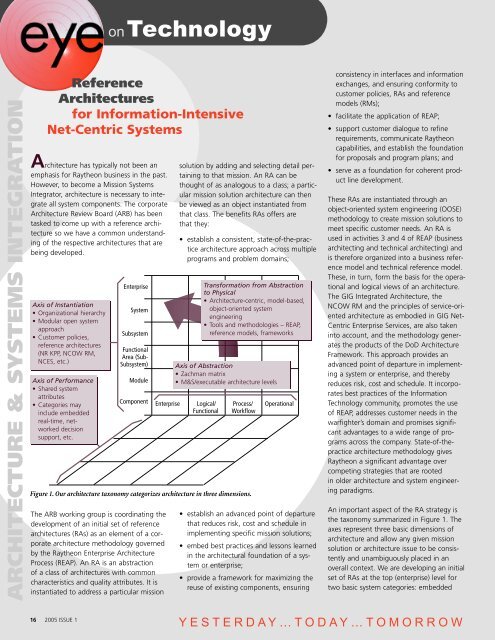RAYTHEON BRINGS EO TECHNOLOGY To Defend Our Nation
RAYTHEON BRINGS EO TECHNOLOGY To Defend Our Nation
RAYTHEON BRINGS EO TECHNOLOGY To Defend Our Nation
You also want an ePaper? Increase the reach of your titles
YUMPU automatically turns print PDFs into web optimized ePapers that Google loves.
ARCHITECTURE & SYSTEMS INTEGRATION<br />
onTechnology<br />
Reference<br />
Architectures<br />
for Information-Intensive<br />
Net-Centric Systems<br />
Architecture has typically not been an<br />
emphasis for Raytheon business in the past.<br />
However, to become a Mission Systems<br />
Integrator, architecture is necessary to integrate<br />
all system components. The corporate<br />
Architecture Review Board (ARB) has been<br />
tasked to come up with a reference architecture<br />
so we have a common understanding<br />
of the respective architectures that are<br />
being developed.<br />
Axis of Instantiation<br />
• Organizational hierarchy<br />
• Modular open system<br />
approach<br />
• Customer policies,<br />
reference architectures<br />
(NR KPP, NCOW RM,<br />
NCES, etc.)<br />
Axis of Performance<br />
• Shared system<br />
attributes<br />
• Categories may<br />
include embedded<br />
real-time, networked<br />
decision<br />
support, etc.<br />
Enterprise<br />
System<br />
Subsystem<br />
Functional<br />
Area (Sub-<br />
Subsystem)<br />
Module<br />
The ARB working group is coordinating the<br />
development of an initial set of reference<br />
architectures (RAs) as an element of a corporate<br />
architecture methodology governed<br />
by the Raytheon Enterprise Architecture<br />
Process (REAP). An RA is an abstraction<br />
of a class of architectures with common<br />
characteristics and quality attributes. It is<br />
instantiated to address a particular mission<br />
solution by adding and selecting detail pertaining<br />
to that mission. An RA can be<br />
thought of as analogous to a class; a particular<br />
mission solution architecture can then<br />
be viewed as an object instantiated from<br />
that class. The benefits RAs offers are<br />
that they:<br />
• establish a consistent, state-of-the-practice<br />
architecture approach across multiple<br />
programs and problem domains;<br />
Axis of Abstraction<br />
• Zachman matrix<br />
• M&S/executable architecture levels<br />
Component Enterprise Logical/ Process/ Operational<br />
Functional Workflow<br />
Figure 1. <strong>Our</strong> architecture taxonomy categorizes architecture in three dimensions.<br />
Transformation from Abstraction<br />
to Physical<br />
• Architecture-centric, model-based,<br />
object-oriented system<br />
engineering<br />
• <strong>To</strong>ols and methodologies – REAP,<br />
reference models, frameworks<br />
• establish an advanced point of departure<br />
that reduces risk, cost and schedule in<br />
implementing specific mission solutions;<br />
• embed best practices and lessons learned<br />
in the architectural foundation of a system<br />
or enterprise;<br />
• provide a framework for maximizing the<br />
reuse of existing components, ensuring<br />
consistency in interfaces and information<br />
exchanges, and ensuring conformity to<br />
customer policies, RAs and reference<br />
models (RMs);<br />
• facilitate the application of REAP;<br />
• support customer dialogue to refine<br />
requirements, communicate Raytheon<br />
capabilities, and establish the foundation<br />
for proposals and program plans; and<br />
• serve as a foundation for coherent product<br />
line development.<br />
These RAs are instantiated through an<br />
object-oriented system engineering (OOSE)<br />
methodology to create mission solutions to<br />
meet specific customer needs. An RA is<br />
used in activities 3 and 4 of REAP (business<br />
architecting and technical architecting) and<br />
is therefore organized into a business reference<br />
model and technical reference model.<br />
These, in turn, form the basis for the operational<br />
and logical views of an architecture.<br />
The GIG Integrated Architecture, the<br />
NCOW RM and the principles of service-oriented<br />
architecture as embodied in GIG Net-<br />
Centric Enterprise Services, are also taken<br />
into account, and the methodology generates<br />
the products of the DoD Architecture<br />
Framework. This approach provides an<br />
advanced point of departure in implementing<br />
a system or enterprise, and thereby<br />
reduces risk, cost and schedule. It incorporates<br />
best practices of the Information<br />
Technology community, promotes the use<br />
of REAP, addresses customer needs in the<br />
warfighter’s domain and promises significant<br />
advantages to a wide range of programs<br />
across the company. State-of-thepractice<br />
architecture methodology gives<br />
Raytheon a significant advantage over<br />
competing strategies that are rooted<br />
in older architecture and system engineering<br />
paradigms.<br />
An important aspect of the RA strategy is<br />
the taxonomy summarized in Figure 1. The<br />
axes represent three basic dimensions of<br />
architecture and allow any given mission<br />
solution or architecture issue to be consistently<br />
and unambiguously placed in an<br />
overall context. We are developing an initial<br />
set of RAs at the top (enterprise) level for<br />
two basic system categories: embedded<br />
16 2005 ISSUE 1 YESTERDAY…TODAY…TOMORROW

















